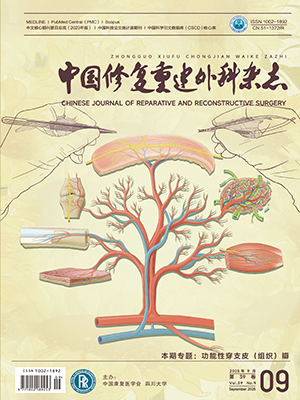| 1. |
陈志伟, 陈丹, 阳海清, 等.双切口联合入路360°内固定治疗高能量闭合性Pilon骨折.中国修复重建外科杂志, 2015, 29(10):1226-1229.
|
| 2. |
肖睿, 唐强, 蔡程, 等.有限内固定结合外固定支架治疗Pilon骨折.中国修复重建外科杂志, 2005, 19(8):603-606.
|
| 3. |
Kitaoka HB, Alexander IJ, Adelaar RS, et al. Clinical rating systems for the ankle-hindfoot, midfoot, hallux, and lesser toes. Foot Ankle Int, 1994, 15(7):349-353.
|
| 4. |
张英泽.老年髋部骨折--中国骨科医师面临的机遇和挑战.中华创伤杂志, 2014, 30(3):193-195.
|
| 5. |
马信龙.认识、重视骨质疏松症, 提高骨质疏松性骨折的诊疗水平.中华骨科杂志, 2014, 34(1):1-5.
|
| 6. |
Chen DW, Li B, Aubeeluck A, et al. Open reduction and internal fixation of posterior Pilon fractures with buttress plate. Acta Ortop Bras, 2014, 22(1):48-53.
|
| 7. |
Haraguchi N, Haruyama H, Toga H, et al. Pathoanatomy of posterior malleolar fractures of the ankle. J Bone Joint Surg (Am), 2006, 88(5):1085-1092.
|
| 8. |
魏世隽, 蔡贤华, 刘曦明, 等.后内侧入路低切迹多向锁定接骨板内固定治疗累及内踝的胫骨后Pilon骨折.中国修复重建外科杂志, 2014, 28(5):558-561.
|
| 9. |
赵宏谋, 梁晓军, 李毅, 等.胫骨远端内外翻畸形对胫距关节接触的影响.中国修复重建外科杂志, 2016, 30(7):826-829.
|
| 10. |
魏世隽, 蔡贤华, 刘曦明, 等.有限切开复位结合锁定加压接骨板内固定治疗胫骨Pilon骨折.中华创伤杂志, 2013, 29(1):49-52.
|
| 11. |
Tang X, Tang PF, Wang MY, et al. Pilon fractures:a new classification and therapeutic strategies. Chin Med J (Engl), 2012, 125(14):2487-2492.
|
| 12. |
俞光荣, 陈大伟, 赵宏谋, 等.支撑钢板固定后侧Pilon骨折的疗效分析.中华创伤杂志, 2013, 29(3):243-248.
|
| 13. |
Klammer G, Kadakia AR, Joos DA, et al. Posterior Pilon fractures:a retrospective case series and proposed classification system. Foot Ankle Int, 2013, 34(2):189-199.
|
| 14. |
魏世隽, 蔡贤华, 黄继锋, 等.内外翻不同损伤机制导致胫骨Pilon骨折的手术策略.中华骨科杂志, 2014, 34(3):298-305.
|
| 15. |
陈雁西, 俞关荣.踝关节骨折的治疗策略与数字化临床路径.中华骨科杂志, 2011, 31(3):275-284.
|
| 16. |
王小平, 韦展图, 黄俭, 等.虚拟三维重建术前规划技术在Pilon骨折的应用研究.中国修复重建外科杂志, 2016, 30(1):44-49.
|
| 17. |
东靖明, 田旭, 马宝通.经踝关节后外侧入路治疗三踝骨折.中华创伤杂志, 2013, 29(6):536-540.
|
| 18. |
李延炜, 洪海森, 刘晖, 等. TightRope治疗下胫腓联合分离的近期疗效.中国修复重建外科杂志, 2016, 30(8):971-974.
|
| 19. |
刘建永.腓骨侧单隧道解剖重建与改良Brostrom法缝合修复治疗慢性踝关节外侧不稳定的对比研究.中国修复重建外科杂志, 2015, 29(10):1214-1220.
|




